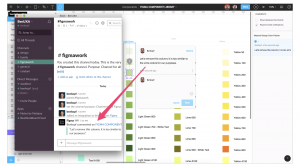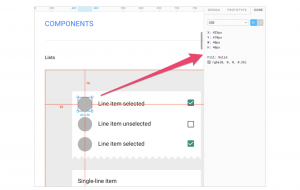Figma Design Software Tutorial 2021: Uses and Insights

The evolution of design tools is greatly influenced by the importance of user experience in the last decade. Attractive new programs are introduced one after another; however, one particular design tool has become one of the most sought after tools for designers. Figma can facilitate the complete design process from start to finish. Initial prototypes, feedback, collaboration, ready-to-test scenarios and developer handoff can be done with its powerful abilities. Moreover, the design tool also reduces the workload of product managers and design teams along with all other stakeholders.
So, how is Figma different from other design tools like Sketch? There are various vital factors, but all of them can be linked back to the fact the Figma is a web-based design application. It created a lot of stir when the design tool was first introduced, but Figma’s flexibility and functionalities slowly made the way. In the blog, we will talk about the uses of Figma and the top hidden features of the design software.
What is Figma?
Figma is a web-based design software and supports real-time collaboration. It is similar to Craft Freehand but with all-inclusive features of Sketch and other famous design software. Figma allows you to work in web browsers, and there are native apps that enable you to work in offline mode. It is an ideal software for web designers, UI/UX designers and other designers who want to enhance the evaluation process of the product working on the same file at the same time. It is also the perfect tool for businesses that need better internal communication.
If you are a freelance designer or a small business with 2 users, you can access the free version with ease. As it is a browser-based application, it works on any computer and operating system. Moreover, it offers a mobile app to preview the design on a mobile screen.
What are the Uses of Figma Software in 2021?
Figma offers an easy-to-use drag and drop interface to design prototypes and working wireframes. It has a variety of engaging elements to animate the wireframes.
Before Figma, multiple other tools were used to streamline the exchange of design mockups. This resulted in a series of back and forth file transfers so multiple stakeholders could review and update the mockups. After Figma, independent tools are no longer required but could be used if you wish. Now, as Figma handles the functions of the independent tools, it needs only one step to shift from sketches to Figma. By doing so, all teams will have the latest mockups and there will be no “handoff” at all.
Figma is an efficient tool for design review feedback. It offers in-app commenting in design and prototyping modes and the comment thread is tracked in Slack or email. There is no requirement to publish PNG files or updates to get feedback from a team using a third-party tool. During design reviews, the design team can work on a large screen, comment and fix issues in the software itself. This kind of feedback is not available in Sketch which requires you to upload to a cloud service to get inputs.
Top-7 hidden features of Figma Software
Let us now look at the top features of Figma and how it can improve your work.
Real-time Collaboration
It is possible to conduct a design review on the go, and simultaneously get feedback on the changes. The time taken between two iterations can be reduced from days to minutes as there is no time wasted due to syncing screens, share links or communicating back and forth.
There are four scenarios that can be intimidating and complex at the same time. All four of these scenarios can be avoided using Figma:
- Once you sync all your screens to InVision and you think you want to change the font size in a footer component, so you update your design file and then re-sync all the screens to InVisio
- If you use Craft to sync a complicated wireframe to InVision and then need like an hour to drag and drop the screens in the correct order as Craft uploads them in a random sequence.
- When a stakeholder in another timezone forgets to upload their work so you have to wait for till they are back online.
- When there is a software update, you would lose crucial time due to crashed plugins.
Works on All Platforms
Figma runs on any operating system with a functional web browser. You can use Macs, Windows PCs, Linux and Chromebooks can use Figma. It is the only design software that allows this which comes in handy when there are devices with multiple operating systems yet everyone can share, open and edit the files.
We have seen that in some companies, designers use Macs and developers are comfortable with Windows PCs. Figma is the key that keeps these groups together. There is no requirement for a mediating mechanism to make design work available to all the parties.
Communication using Slack

Slack is the preferred communication medium in Figma. As soon as a Figma channel is created in Slack, all comments along with updates made in Figma are “slacked” to all the stakeholders. This feature is vital during design as updates to a Figma file will change every further instance where the file is located. Updates in a wireframe are addressed in time and the feedback channel is live.
Flexible File Sharing

Figma supports permission-based sharing of any file, page or frame. It is also known as an artboard in other applications. As soon as a share link is created to a frame on a page, the stakeholder clicking on that link will see Figma’s browser version and a zoomed-in view of the loaded frame. The application will share files, pages and entire projects with anyone that has permission.
This type of selective sharing, from files to frames, allows designers and developers to share only what is required in bug tracking tools and software like SharePoint.
Developer Handoff

Figma shows code snippets on any selected frame or object in CSS, iOS or Android formats for developers to use when reviewing a design file. The design elements can be viewed/edited by any developer at any point in time. You do not need a third-party tool to obtain the information. Now, Figma has seamless integration with Zeplin if teams want to do more than simple measurement and CSS display.
All Files in One Place
As Figma is an online tool, it handles file organization by showing projects and files in a dedicated view. Just like Sketch, Figma too supports agile teams can organize their projects. You can create a project, a file or a page for each user story. It is one of the best ways to organize files that could be made more or less granular based on system requirements.
Third-Party Integration
Recently, Figma has introduced developers APIs to enable true integration with any browser-based app. Businesses are using this to integrate live displays of design files in their applications. For instance, Uber has large screens showing design files around their organization. The designs are public and Uber encourages users to share feedback with the company.
Atlassian’s JIRA tool has included a Figma add-on for developers, owners and quality engineers. Moreover, Figma’s API promises to fulfil customer requests for third-party plugins and showcase enhancements that Sketch offers.
Wrapping Up
Figma is a browser-based UI and UX design software with impeccable design, wireframing and code-generation capabilities. It is undoubtedly the best design software with robust features which support users working on each and every design phase. If you have not already tried it, you must give it a try. Let us know about your favourite design tool in the comments below.

Dhruvil is a Writer & Marketeer for Nimblechapps, joining December 2014, based out of Sydney, Australia. He has worked briefly as a Branding and Digital Marketing Manager before moving to Australia. At Nimblechapps, he worked on Social Media Marketing, Branding, Email Marketing and Blogging. Dhruvil studies Business at University of Western Sydney, and also handles Operations for the company in Australia.




